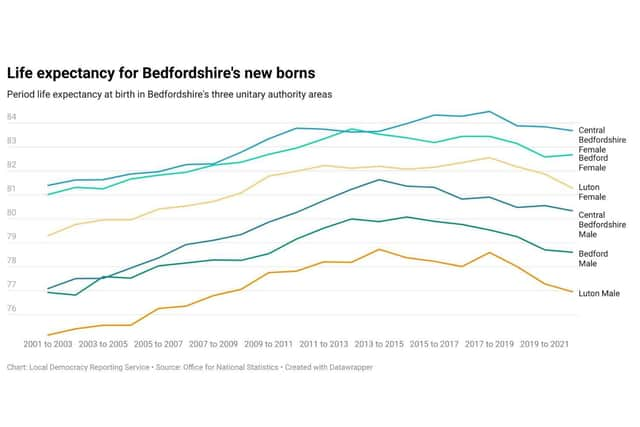Life expectancy for people born in Luton is the lowest in the county according to new statistics


Life expectancy for recent Luton newborns is the lowest in Bedfordshire, according to data from the Office for National Statistics.
But the Bedfordshire, Luton and Milton Keynes Integrated Care Board (BLMK ICB) said there is “insufficient data” to explain the differences between areas.
Advertisement
Advertisement
A spokesman for BMLK said: “Change in life expectancy occurs over many years and is influenced over the life course of an individual.”


The Office for National Statistics (ONS) data shows that a Luton male born in 2020/22 is predicted to have a life expectancy that is over three years lower than a Central Beds male – and a Central Beds newborn female is predicted to live nearly two and a half years longer than a Luton female
A Luton Borough Council spokesperson said: “Life expectancy is affected by many factors, such as health-related behaviours such as smoking and diet, access to and use of health services and wider socioeconomic determinants such as housing, education and income as well as the overall level of deprivation in an area.
“There are a number of factors which may explain why life expectancy in Luton is lower than its neighbours, including high levels of deprivation, poor housing quality in parts of Luton, population density, education, employment and the interaction of these factors.
Advertisement
Advertisement
“However, patterns in life expectancy in Luton reflect the causes and patterns seen across the country – this is not just a Luton issue, and relates to the underlying demographics and inequalities.”
The council said the Joint Strategic Needs Assessment (JSNA) on the Luton Observatory provides a more detailed look at the health of Luton and describes the needs of its population using data to identify improvements, challenges, and areas that need further investigation.
“The Luton population wellbeing strategy is our statutory Joint Health and Wellbeing strategy,” the council spokesperson added.
“It’s a partnership strategy and a key delivery vehicle for our 2040 ambition which includes improving wellbeing and addressing inequalities.
Advertisement
Advertisement
“Our recent ‘One year on’ review looked at what we have achieved over the last year, and helped to refocus our priorities for the coming year to ensure we continue to deliver against the strategy and priorities within the community.
“We are collaborating with local health agencies, community organisations, and other stakeholders to ensure a comprehensive and coordinated approach to public health improvement through various boards and forums.
“These include the Health and Wellbeing Board, Supporting You (Luton Food First), Luton Access and Fairness Taskforce.
“Using this approach we aim to engage and empower residents in actively participating in their own health and wellbeing,” they said.
Advertisement
Advertisement
A BLMK ICB spokesperson said: “Life expectancy is impacted by a wide variety of things, including inherited conditions, levels of deprivation, local environment including air quality, schooling, being in meaningful work, stable positive relationships, access to green spaces, access to high quality health care.
“Across BLMK various services including local authorities, the NHS, VCSE groups and others work collaboratively to support people towards healthier lifestyles.
“Programmes include smoking cessation, healthy eating and weight management, and many of these also now benefit from apps to help people monitor their progress at their own speed.
“There are also screening programmes for cancers and other conditions; blood pressure monitoring is now available in many pharmacies.”